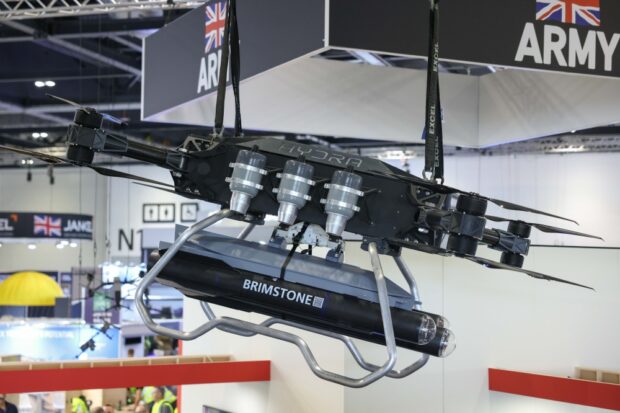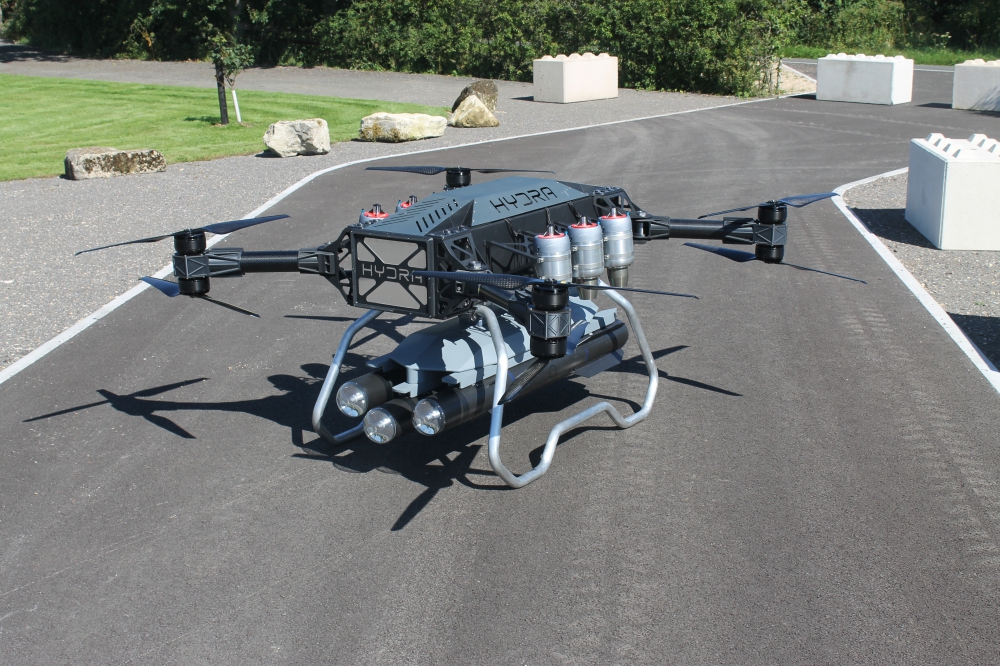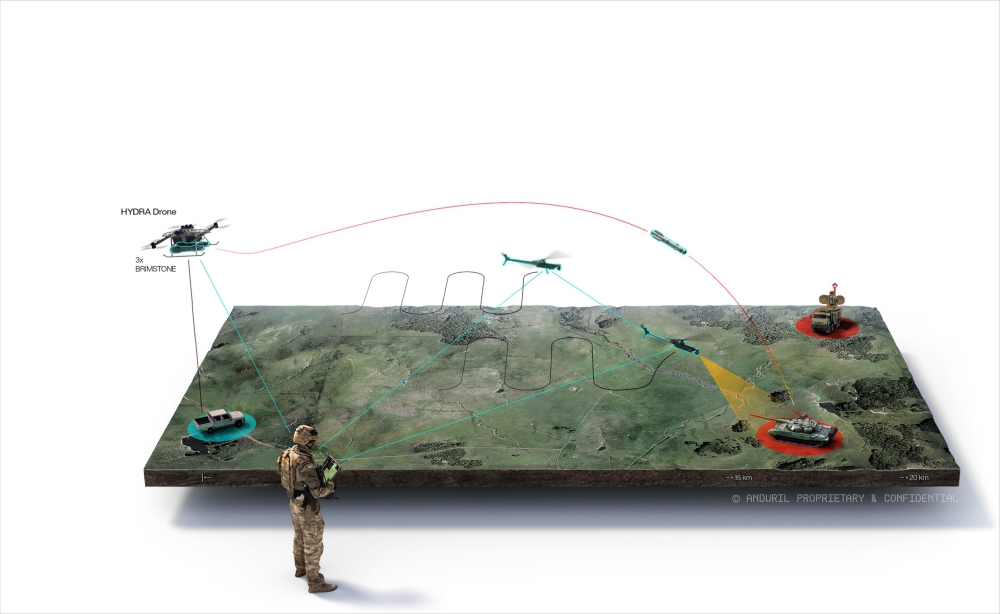A drone that fires laser-guided missiles will be the centrepiece of a major international Defence exhibition in London from 12 to 15 September.
Featuring over 1,500 defence and security suppliers, DSEI 2023 at the ExCeL will bring together governments, the armed forces and industry representatives from all over the world.
On display at the British Army’s stand at DSEI will be the Hydra 400 drone alongside an Aether mothership.
The Hydra 400 is a pioneering new generation of heavy lift drone using hybrid propulsion technology. Compact and portable, the drone can be transported in the back of a Hilux or similar and assembled ready for flight in six minutes.
The drone is powered by single spool jet turbines, producing 500N (50kg) thrust providing a maximum lift of 400kg.
Ministry of Defence (MoD) funding will be needed for Hydra Drones Ltd, the company that developed Hydra 400, to progress the concept.
It is proposed that the Hydra 400 carry a lethal payload, the Brimstone missile developed by Stevenage-based MBDA, which is the strategic partner to the MoD for complex weapons
The Brimstone missile weighs 50kg, is 1.8 metres in length and has a 180mm diameter. It is guided by millimetric wave radar and semi-active laser.
Brimstone offers ‘one missile, multi-platform’ versatility and is designed to be integrated onto helicopters, fixed wing aircraft, including fast jets, land vehicles, naval platforms and unmanned aerial vehicles (UAVs).
The missile is battle proven with over 98% success rate in defeating static, moving and manoeuvring target sets including main battle tanks and other armoured vehicles.
An Anduril Ghost Drone provides real time Artificial Intelligence, surveillance and multi-mission reconnaissance capability. Combined with the versatility of the Hydra drone and the precision of the Brimstone missile, this is a fully automated ‘end to end’ decision support weapon system.
Joining forces with Hydra Drones in this innovative sovereign capability, that can be delivered at pace with the right investment, is an exciting joint Army/industry opportunity.DAVE ‘POS’ POSTLETHWAITE MBE, MBDA’S HEAD OF UAS SALES
General Sir Patrick Sanders, Army Chief of the General Staff, says:
“We are responding to the operating environment that we see in Ukraine. For example, I am struck by the fact that in the evolving Ukraine drone campaign, 40% of losses are attributed to pilot error.
“When the electro-magnetic spectrum is so heavily contested, automation fails, and the skill of the pilot predominates. We need ‘war fighters’ – whether they are cyber specialist, drone pilots or infantry soldiers – to be stronger, faster, more intelligent and more resilient.
“By the end of this year, we will form a new UAS Group within a reorientated Joint Aviation Command, providing a focal point for industry, around which we intend to develop the next generation of UAS platforms in ever closer partnership.”
At DSEI earlier today, General Sir Patrick Sanders spoke about the continued restructure and modernisation of the Army, in line with its Future Soldier programme and informed by the lessons of Ukraine.
If funding is provided by the MoD, Hydra and a dummy-payload representing Brimstone will be tested during the next phase of the Army’s Warfighting Experiment (AWE).
This is a series of trials and experiments across the UK and overseas where industry partners have been tasked with providing solutions to the challenges of urban warfare, harnessing tech to prepare for complex future warfare.
The next AWE phase, known as Exercise Blunting Strike, will take place at Copehill Down in November.
Dr Stephen Prior, CEO of Hydra Drones Ltd said:
“The Army Warfighting Experiment has provided the framework and opportunity for British SMEs, like Hydra Drones Ltd, to collaborate with traditional primes, such as MBDA, but also to be competitive in their own right and innovate at a speed that larger companies might struggle with.”
Dave ‘Pos’ Postlethwaite MBE, MBDA’s Head of UAS sales said:
“MBDA is committed to supporting the British Army by delivering cutting edge and UK sovereign battle-winning technology in-line with the Land Industrial Strategy, Op Mobilise and Future Soldier.
“Joining forces with Hydra Drones in this innovative sovereign capability, that can be delivered at pace with the right investment, is an exciting joint Army/industry opportunity.”
In the forefront of the Army’s Future Soldier programme is 2nd Battalion The Royal Yorkshire Regiment who are testing cutting-edge technology.
With drones taking centre stage on battlefields across the globe, cutting-edge uncrewed aircraft systems (UAS) have been tested by the Army.
At last year’s Army Warfighting Experiment in Portsmouth Naval Base, a range of UAS systems that use different technologies to defeat drones were put through their paces.
One such system was the Wingman, a wearable RF sensor for drone detection, and the Pitbull, a wearable jammer that utilises smart jamming to defeat enemy drones. This effective portable counter-UAS system will protect dismounted soldiers and ensure they are less susceptible to detection and attack.
Some of the other unique drone capabilities tested included carrying blood plasma to injured soldiers on the battlefield while other drones demonstrated how it can evacuate casualties.
The Hydra XL 300 and Malloy T400 drones, for instance, showed how they could lift a casualty of up to 120kg over a range of up to 25km, with spare capacity and zero emissions.
The results of AWE will provide evidence to inform the Army and Defence which capabilities should be invested in and developed for the Army to remain competitive on the global stage.
This collaboration with industry is about using the solutions they already have, to counter the problems faced by the British Army, without spending time and money going back to the drawing board and starting from scratch.



